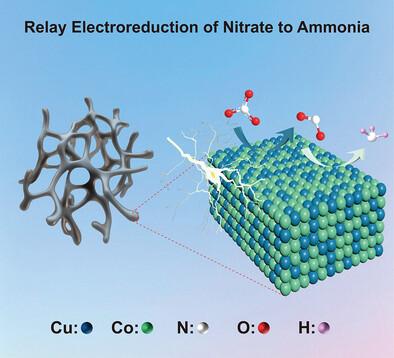硝酸继电还原制氨的高性能CuCo气凝胶电催化剂
IF 19
1区 材料科学
Q1 CHEMISTRY, MULTIDISCIPLINARY
引用次数: 0
摘要
可再生能源驱动的硝酸电还原制氨为可持续氨合成提供了一条低碳和有前途的途径。对于铜基电催化剂,由于其加氢过程动力学缓慢,亚硝酸盐经常在电催化剂表面积累,导致氨收率和选择性低,电催化剂失活严重。本文提出了一种将Cu─Co中继点整合成互连多孔网络的连续中继点构建策略。Cu50Co50气凝胶由于充分暴露了Cu─Co互连位点,调节了硝酸盐和中间体的吸附能,促进了加氢能力,并具有良好的三维骨架自支撑性,实现了高效的继电催化,在−0.2 V时NH3产率达到3.3±0.27 mmol·h−1·cm−2(2110±173 mmol·h−1·gcat−1),与RHE相比NH3法拉第效率高达≈100%。在工业级电流密度的电催化中,Cu50Co50气凝胶的潜在需求即使在100小时的时间电位测量后也保持稳定,表现出出色的长期稳定性。此外,可以轻松实现Cu50Co50气凝胶的大规模制备(> 1g),并始终保持其优异的性能。这种连续继电站点建设策略,为开发高效继电催化的先进电催化剂开辟了新的途径。本文章由计算机程序翻译,如有差异,请以英文原文为准。

High-Performance CuCo Aerogel Electrocatalyst for Relay Electroreduction of Nitrate to Ammonia
Renewable energy-driven electroreduction of nitrate to ammonia presents a low-carbon and promising route for sustainable ammonia synthesis. For Cu-based electrocatalysts, due to their sluggish kinetics of the hydrogenation steps, nitrite often accumulates on the electrocatalysts surface, resulting in low ammonia yield rate and selectivity, as well as serious deactivation of electrocatalysts. Herein, a continuous relay site construction strategy that integrates the Cu─Co relay sites into an interconnected porous network is proposed. Owing to the adequately exposed interconnected Cu─Co relay sites, regulated adsorption energy of the nitrate and intermediates, promoted hydrogenation ability, and excellent self-supportability of 3D skeleton, the Cu50Co50 aerogel realizes the high-efficiency relay catalysis with an ultrahigh NH3 yield rate of 3.3 ± 0.27 mmol·h−1·cm−2 (2110 ± 173 mmol·h−1·gcat−1) and a large NH3 Faraday efficiency of ≈100% at −0.2 V vs. RHE. The potential need for the Cu50Co50 aerogel in the electrocatalysis at an industrial-level current density remains stable even after 100-h chronopotentiometry measurement, demonstrating excellent long-term stability. Besides, the large-scale preparation (>1 g) of the Cu50Co50 aerogel can be easily achieved, and its exceptional performance is maintained consistently. Such a continuous relay site construction strategy opens a new way for developing advanced electrocatalysts for high-efficiency relay catalysis.
求助全文
通过发布文献求助,成功后即可免费获取论文全文。
去求助
来源期刊

Advanced Functional Materials
工程技术-材料科学:综合
CiteScore
29.50
自引率
4.20%
发文量
2086
审稿时长
2.1 months
期刊介绍:
Firmly established as a top-tier materials science journal, Advanced Functional Materials reports breakthrough research in all aspects of materials science, including nanotechnology, chemistry, physics, and biology every week.
Advanced Functional Materials is known for its rapid and fair peer review, quality content, and high impact, making it the first choice of the international materials science community.
 求助内容:
求助内容: 应助结果提醒方式:
应助结果提醒方式:


